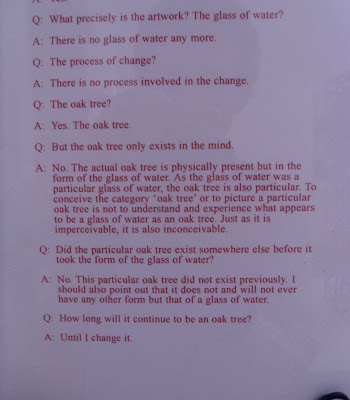Foolishly, in retrospect almost absurdly, I thought that I would be able to resist including further art criticism among this catalogue of literary sketch. But, after a 5 week whirlwind through Greece, Rome, and Florence studying Classical, Renaissance, and Christian art, could anyone expect me not to cave upon my return to London, the Mecca of art plundered from every major culture around the world? So for my readers who have grown weary of academic commentary on monumental pieces of art in some of the world’s most renowned museums and were hoping for lighter reading, I advise you to perhaps indulge in a rousing round of Farmville and tune back in for my next piece.
Another gem I discovered was not a piece but this wise quote by John Craxton from 1946:
The museum planned for this evening was certainly to be a good one. No, I would not be drifting through pieces commandeered from around the world, tonight’s destination was Tate Britain, a collection of art that is actually from Britain (unlikely though it may seem to visitors of The British Museum). As good Providence would have it, the first exhibit I encountered featured British Romantic paintings, a style with which I was not familiar. Naturally, I was delighted.
As I read the signs on the wall I learned that the Romantics were tormented artists passionately obsessed with experiencing, examining, and portraying human emotions, the human condition. Gazing from piece to piece it was clearly apparent why:
What tragic lives these men led--I can only begin to imagine the hardship, the burden of living with such poor eyesight! If this is how the world looked to me I certainly would be be upset as well.
From British Romantics I moved to an exhibit of selections from the 20th century. I especially enjoyed this graceful piece constructed of steel and vinyl, “Art For Other People #24”, an uplifting celebration of the joy the artist feels in having the profound opportunity to share an intimate glimpse into his own psyche through artistic expression:
Here’s another piece I found inspiring:
Now I know, you may be feeling a bit baffled, as was I when first I saw it. But have faith, this artist has not left us to wander in a cold dark abyss, all is revealed by the insightful title: “Car Door, Ironing Board and Twin-Tub with North American Indian Head-Dress”. Silly me trying to read some sort of angsty interpretation regarding the conquest of Native-American culture by the cold, impersonal materialism of modern America when in reality it’s just about a car door, ironing board, twin-tub, and headdress!
Another gem I discovered was not a piece but this wise quote by John Craxton from 1946:
But why explain pictures? No meal can be made more exciting by a running commentary analysis of the flavours. Everyone has a different tongue. Pictures need no literary introduction. What they always need are open eyes and minds free from preconceived ideas.
With this in mind, I will refrain from comment and allow the most profound piece at the exhibit, the piece which elicited by far the deepest emotional reaction, to speak for itself. The title is “Oak Tree”, the media: glass, water, paper, and ink.









"I think that I shall never drink a poem as lovely as this tree ..."
ReplyDeleteWhat happens when the water evaporates? Does the tree become a bird?
ReplyDelete